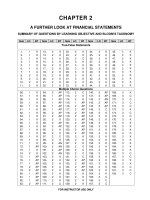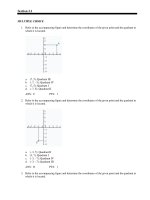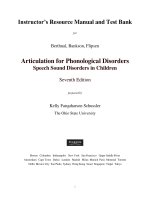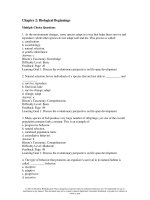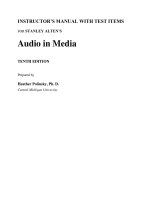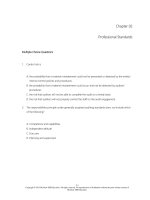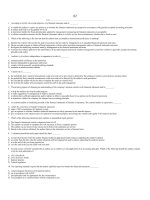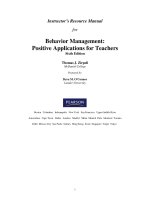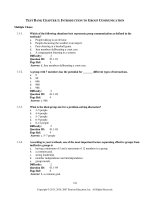Working in groups 6th edition engleberg test bank
Bạn đang xem bản rút gọn của tài liệu. Xem và tải ngay bản đầy đủ của tài liệu tại đây (305.58 KB, 23 trang )
TEST BANK CHAPTER 1: INTRODUCTION TO GROUP COMMUNICATION
Multiple Choice
1.1-1.
Which of the following situations best represents group communication as defined in the
textbook?
a. People talking in an elevator.
b. People discussing the weather at an airport.
c. Fans cheering at a baseball game.
d. Jury members deliberating a court case.
e. A congregation listening to a sermon.
2
Difficulty:
01.1-01
Question ID:
3
Page Ref:
Answer: d. Jury members deliberating a court case.
1.1-2.
A group with 7 members has the potential for _______ different types of interactions.
a. 9
b. 90
c. 666
d. 900
e. 966
2
Difficulty:
01.1-02
Question ID:
4
Page Ref:
Answer: e. 966
1.1-3.
What is the ideal group size for a problem-solving discussion?
a. 3–5 people
b. 4–6 people
c. 5–7 people
d. 6–9 people
e. 8–12 people
2
Difficulty:
01.1-03
Question ID:
4
Page Ref:
Answer: c. 5–7 people
1.1-4.
According to your textbook, one of the most important factors separating effective groups from
ineffective groups is
a. having a minimum of 5 and a maximum of 12 members in a group.
b. a common goal.
c. strong leadership.
d. member independence and interdependence.
e. group morale.
2
Difficulty:
01.1-04
Question ID:
6
Page Ref:
Answer: b. a common goal.
318
Copyright © 2013, 2010, 2007 Pearson Education, Inc. All Rights Reserved.
1.1-5.
According to your textbook, a group's context refers to
a. the type and size of the group.
b. the group's physical and psychological setting.
c. the group's purpose, history, and status.
d. the characteristics of and relationships among group members.
e. all of the above.
2
Difficulty:
01.1-05
Question ID:
12
Page Ref:
Answer: e. all of the above.
1.1-6.
To which basic element of communication is Grace giving special attention when she prepares
for an important group meeting by making sure her business suit is pressed, that her hair is
well-groomed, that her perfume is pleasant but subtle, and that she takes a breath mint before
entering the meeting room?
a. channels
b. external noise
c. feedback
d. verbal message
e. internal noise
3
Difficulty:
01.1-06
Question ID:
12
Page Ref:
Answer: a. channels
1.1-7.
In a communication transaction, feedback represents
a. a group's physical and psychological environment.
b. anything that interferes with or inhibits effective communication.
c. the media through which group members share messages.
d. the response or reaction to a message.
e. ideas, information, opinions, and/or feelings that generate meaning.
2
Difficulty:
01.1-07
Question ID:
12
Page Ref:
Answer: d. the response or reaction to a message.
1.1-8.
Which of the following examples best illustrates the systems theory principle that "systems try to
maintain balance in their environment"?
a. Members may take time off to "play" when work becomes too intense.
b. Members may unexpectedly come up with new ideas and techniques.
c. Effective groups have clear goals.
d. Groups suffer if members fail to cooperate.
e. Groups rely on member input to achieve a common goal.
3
Difficulty:
01.1-08
Question ID:
5
Page Ref:
Answer: a. Members may take time off to "play" when work becomes too intense.
319
Copyright © 2013, 2010, 2007 Pearson Education, Inc. All Rights Reserved.
1.1-9.
The cooperative interaction of several factors that results in a combined effect greater than the
total of all individual parts is referred to as
a. interaction.
b. common goals.
c. interdependence.
d. synergy.
e. working.
2
Difficulty:
01.1-09
Question ID:
13
Page Ref:
Answer: d. synergy.
1.1-10.
A stamp collecting club is an example a
a. self-help group.
b. social group.
c. learning group.
d. service group.
e. public group.
1
Difficulty:
01.1-10
Question ID:
6-8
Page Ref:
Answer: b. social group.
1.1-11.
Your family is an example of a
a. primary group.
b. social group.
c. public group.
d. service group.
e. none of the above
1
Difficulty:
01.1-11
Question ID:
6-8
Page Ref:
Answer: a. primary group.
1.1-12.
A local Alcoholics Anonymous chapter is an example of a
a. primary group.
b. self-help group.
c. learning group.
d. service group.
e. public group.
2
Difficulty:
01.1-12
Question ID:
6-8
Page Ref:
Answer: b. self-help group.
320
Copyright © 2013, 2010, 2007 Pearson Education, Inc. All Rights Reserved.
1.1-13.
Guests who appear on talk shows and interact with other guests for the benefit of an audience
are participating in a
a. symposium.
b. forum.
c. panel discussion.
d. governance group.
e. service group.
1
Difficulty:
01.1-13
Question ID:
7
Page Ref:
Answer: c. panel discussion.
1.1-14.
Members of a PTA getting together to hold a carnival for elementary school students
represents what type of group.
a. symposium
b. forum
c. civic group
d. governance group
e. self-help group
2
Difficulty:
01.1-14
Question ID:
7
Page Ref:
Answer: c. civic group
1.1-15.
A college appoints a moderator and holds an open discussion to provide students with the
opportunity to ask questions and express their concerns regarding a proposed increase in
tuition. This setting for group communication is an example of a
a. symposium.
b. forum.
c. panel discussion.
d. governance group.
e. service group.
2
Difficulty:
01.1-15
Question ID:
7
Page Ref:
Answer: b. forum.
1.1-16.
A college's Board of Trustees that makes public policy decisions may be classified as a
a. symposium.
b. forum.
c. panel discussion.
d. governance group.
e. service group.
1
Difficulty:
01.1-16
Question ID:
7
Page Ref:
Answer: d. governance group.
321
Copyright © 2013, 2010, 2007 Pearson Education, Inc. All Rights Reserved.
1.1-17.
Which of the following characteristics demonstrates one of the disadvantages of working in
groups?
a. Groups make better decisions when working on complex tasks.
b. Working in groups enhances member learning.
c. Groups require significant time, energy, and resources.
d. Groups are often more creative than members working alone.
e. Members usually enjoy working with others in groups.
2
Difficulty:
01.1-17
Question ID:
8-11
Page Ref:
Answer: c. Groups require significant time, energy, and resources.
1.1-18.
A virtual group is one which
a. relies on technology to communicate.
b. exists only for a short period of time.
c. lacks a leader.
d. lacks a clear purpose.
e. has the same dynamic as other groups.
1
Difficulty:
01.1-18
Question ID:
8
Page Ref:
Answer: a. relies on technology to communicate.
1.1-19.
Statements that explain or predict how people communicate are
a. theories.
b. strategies.
c. skills.
d. resources.
e. rules.
1
Difficulty:
01.1-19
Question ID:
12
Page Ref:
Answer: a. theories.
1.1-20.
When seeking to resolve group tensions, the dialectic approach recommends a
__________________ approach.
a. compromise
b. either/or
c. both/and
d. approach/avoidance
e. task/maintenance
2
Difficulty:
01.1-20
Question ID:
14
Page Ref:
Answer: c. both/and
322
Copyright © 2013, 2010, 2007 Pearson Education, Inc. All Rights Reserved.
1.1-21.
All of the following pairs of common folk proverbs illustrate the contradictory nature of
dialectic tensions EXCEPT:
a. "Opposites attract" and "Birds of a feather flock together."
b. "Two's company, three's a crowd" and "The more the merrier."
c. "Look before you leap" and "He who hesitates is lost."
d. "Waste not, want not" and "Music makes the world go 'round.”
e. "To know him is to love him" and "Familiarity breeds contempt."
3
Difficulty:
01.1-21
Question ID:
13-14
Page Ref:
Answer: d. "Waste not, want not" and "Music makes the world go 'round."
1.1-22.
In group dialectic terms, effective groups balance structure and
a. heterogeneity.
b. disengagement.
c. spontaneity.
d. engagement.
e. individual goals.
2
Difficulty:
01.1-22
Question ID:
14-18
Page Ref:
Answer: c. spontaneity.
1.1-23.
In dialectic terms, effective groups balance conflict with
a. conformity.
b. cohesion.
c. structure.
d. closed systems.
e. social dimensions.
2
Difficulty:
01.1-23
Question ID:
14-18
Page Ref:
Answer: b. cohesion.
1.1-24.
In dialectic terms, effective groups balance task dimensions with
a. conformity dimensions.
b. cohesion dimensions.
c. structure dimensions.
d. closed dimensions.
e. social dimensions.
2
Difficulty:
01.1-24
Question ID:
14-18
Page Ref:
Answer: e. social dimensions.
323
Copyright © 2013, 2010, 2007 Pearson Education, Inc. All Rights Reserved.
1.1-25.
The open system ↔ closed system group dialectic can be described as
a. balancing a commitment to group norms and standards with a willingness to differ and change.
b. balancing member similarities and differences.
c. balancing external support and recognition with internal group solidarity and rewards.
d. balancing member energy and labor with the group's need for rest and renewal.
e. balancing members' personal goals with the group's goal.
3
Difficulty:
01.1-25
Question ID:
14-18
Page Ref:
Answer: c. balancing external support and recognition with internal group solidarity and rewards.
1.1-26.
The homogeneous ↔ heterogeneous group dialectic can be described as
a. balancing a commitment to group norms and standards with a willingness to differ and change.
b. balancing member similarities and differences.
c. balancing external support and recognition with internal group solidarity and rewards.
d. balancing effective leadership with responsible followership.
e. balancing members' personal goals with the group's common goal.
2
Difficulty:
01.1-26
Question ID:
14-18
Page Ref:
Answer: b. balancing member similarities and differences.
1.1-27.
The engaged ↔ disengaged group dialectic can be described as
a. balancing a commitment to group norms and standards with a willingness to differ and change.
b. balancing a motivation to complete tasks with promoting member relationships.
c. balancing external support and recognition with internal group solidarity and rewards.
d. balancing effective leadership with responsible followership.
e. balancing member energy and labor with the group's need for rest and renewal.
2
Difficulty:
01.1-27
Question ID:
14-18
Page Ref:
Answer: e. balancing member energy and labor with the group's need for rest and renewal.
1.1-28.
A both/and approach to resolving dialectic tensions in groups empowers members. Which of
the following examples demonstrates the characteristics of autonomy in an empowered group?
a. The group believes it has the ability to achieve its common goal.
b. The group believes that its common goal is important and worthwhile.
c. The group has the freedom to make decisions and implements its decisions.
d. The group believes that its work produces significant benefits for other people and
organizations.
e. The group has high morale and understands the value of play as well as work.
2
Difficulty:
01.1-28
Question ID:
14-18
Page Ref:
Answer: c. The group has the freedom to make decisions and implements its decisions.
324
Copyright © 2013, 2010, 2007 Pearson Education, Inc. All Rights Reserved.
1.1-29.
In Latin, the word credo means
a. "I believe."
b. "I mean."
c. "I am."
d. "I create."
e. "I accuse."
2
Difficulty:
01.1-29
Question ID:
19
Page Ref:
Answer: a. "I believe."
1.1-30.
All of the following principles of ethical communication are included in the National
Communication Association's Credo for Ethical Communication EXCEPT:
a. We endorse freedom of speech only when the truth does not cause detrimental results or harm
others.
b. We advocate truthfulness, accuracy, honesty, and reason as essential to the integrity of
communication.
c. We strive to understand and respect other communicators before evaluating and responding to
their messages.
d. We are committed to the courageous expression of personal conviction in pursuit of fairness and
justice.
e. We promote a communication climate of caring and mutual understanding.
2
Difficulty:
01.1-30
Question ID:
19-20
Page Ref:
Answer: a. We endorse freedom of speech only when the truth does not cause detrimental results or
harm others.
1.1-31.
A group with 5 members has the potential for _____ different types of interactions.
a. 95
b. 90
c. 105
d. 190
e. 100
2
Difficulty:
01.1-31
Question ID:
4
Page Ref:
Answer: b. 90
1.1-32.
The ideal size of a small group is dependent upon:
a. member knowledge.
b. attitudes.
c. skills.
d. task.
e. all of the above.
2
Difficulty:
01.1-32
Question ID:
4
Page Ref:
Answer: e. all of the above.
325
Copyright © 2013, 2010, 2007 Pearson Education, Inc. All Rights Reserved.
1.1-33.
Theory which describes a collection of interacting, interdependent elements working together
to form a complex whole.
a. relational dialectics
b. Homogenous
c. systems
d. optimal group
e. closed
2
Difficulty:
01.1-33
Question ID:
5
Page Ref:
Answer: c. systems
1.1-34.
The purpose or objective towards which a group is directed is called
a. interaction.
b. interdependence.
c. context.
d. goal.
e. working.
2
Difficulty:
01.1-34
Question ID:
6
Page Ref:
Answer: d. goal.
1.1-35.
The following are each examples of synchronous communication EXCEPT:
a. audioconferences.
b. email.
c. videoconferences.
d. test conferences.
e. webinars.
2
Difficulty:
01.1-35
Question ID:
8
Page Ref:
Answer: b. email.
1.1-36.
The following are advantages of working in a group EXCEPT:
a. member satisfaction.
b. cultural understanding.
c. more time.
d. creativity.
e. learning.
2
Difficulty:
01.1-36
Question ID:
9
Page Ref:
Answer: c. more time.
326
Copyright © 2013, 2010, 2007 Pearson Education, Inc. All Rights Reserved.
1.1-37.
The contradictory tensions groups experience as they work together are known as
a. group dialectics.
b. group goals.
c. systems theory.
d. interdependence.
e. goal theory.
2
Difficulty:
01.1-37
Question ID:
11
Page Ref:
Answer: a. group dialectics.
1.1-38.
The following are examples of group dialectics EXCEPT:
a. conflict cohesion.
b. conforming-nonconforming
c. task-social.
d. membership-followership.
e. homogenous-heterogeneous.
2
Difficulty:
01.1-38
Question ID:
16
Page Ref:
Answer: d. membership-followership.
1.1-39.
In optimal group experiences, members
a. are focused.
b. perform at a high level.
c. are highly motivated.
d. creative thinkers.
e. all of the above.
2
Difficulty:
01.1-39
Question ID:
18
Page Ref:
Answer: e. all of the above.
True/False
1.2-1.
According to a study commissioned by the Association of American Colleges and Universities,
"teamwork skills and the ability to collaborate with others in diverse group settings" was
ranked first as an essential learning outcome in 2 of 4 major categories.
a. True
b. False
1
Difficulty:
01.2-01
Question ID:
3
Page Ref:
Answer: a. True
327
Copyright © 2013, 2010, 2007 Pearson Education, Inc. All Rights Reserved.
1.2-2.
Employers view proficiency in a field of study as more important than group communication
skills.
a. True
b. False
2
Difficulty:
01.2-02
Question ID:
3
Page Ref:
Answer: b. False
1.2-3.
Your textbook defines group communication as the interaction of 5 to 7 people working to make
a good decision.
a. True
b. False
2
Difficulty:
01.2-03
Question ID:
3
Page Ref:
Answer: b. False
1.2-4.
The basic components of group communication are members, interaction, independence, goals,
and working.
a. True
b. False
2
Difficulty:
01.2-04
Question ID:
3-6
Page Ref:
Answer: a. True
1.2-5.
A group of 5 members has the potential for 90 different types of interaction.
a. True
b. False
2
Difficulty:
01.2-05
Question ID:
4
Page Ref:
Answer: a. True
1.2-6.
In groups with more than 15 members, coordination and control become difficult.
a. True
b. False
1
Difficulty:
01.2-06
Question ID:
4
Page Ref:
Answer: a. True
328
Copyright © 2013, 2010, 2007 Pearson Education, Inc. All Rights Reserved.
1.2-7.
According to your textbook, leadership is the single factor that separates successful groups from
unsuccessful groups.
a. True
b. False
2
Difficulty:
01.2-07
Question ID:
6
Page Ref:
Answer: b. False
1.2-8.
As groups grow larger, member satisfaction increases.
a. True
b. False
2
Difficulty:
01.2-08
Question ID:
5
Page Ref:
Answer: b. False
1.2-9.
Generally, there are 2 sources of noise: external and internal.
a. True
b. False
2
Difficulty:
01.2-09
Question ID:
12
Page Ref:
Answer: a. True
1.2-10.
A soft speaking voice can create noise in a communication transaction.
a. True
b. False
2
Difficulty:
01.2-10
Question ID:
12
Page Ref:
Answer: a. True
1.2-11.
Feedback is always verbal rather than nonverbal.
a. True
b. False
2
Difficulty:
01.2-11
Question ID:
12
Page Ref:
Answer: b. False
1.2-12.
When group members work together to achieve a common goal, the size of the group, the
physical setting, and the group's role and status in an organization are components of the
communication context.
a. True
b. False
2
Difficulty:
01.2-12
Question ID:
12
Page Ref:
Answer: a. True
329
Copyright © 2013, 2010, 2007 Pearson Education, Inc. All Rights Reserved.
1.2-13.
Your biases, distracting thoughts about other activities, fatigue, and hunger can cause noise in
a communication transaction.
a. True
b. False
2
Difficulty:
01.2-13
Question ID:
12
Page Ref:
Answer: a. True
1.2-14.
Unlike the digestive system, a computer system, or even the solar system, groups do not
function as a system because they involve interdependent members interacting with one
another.
a. True
b. False
2
Difficulty:
01.2-14
Question ID:
5
Page Ref:
Answer: b. False
1.2-15.
Systems theory assumes that groups and their members are unpredictable.
a. True
b. False
2
Difficulty:
01.2-15
Question ID:
5
Page Ref:
Answer: a. True
1.2-16.
The term synergy comes from the Greek word synonym which means "similar meaning."
a. True
b. False
2
Difficulty:
01.2-16
Question ID:
13
Page Ref:
Answer: b. False
1.2-17.
Synergy refers to a situation in which "the whole is greater than the sum of its individual
parts."
a. True
b. False
2
Difficulty:
01.2-17
Question ID:
13
Page Ref:
Answer: a. True
330
Copyright © 2013, 2010, 2007 Pearson Education, Inc. All Rights Reserved.
1.2-18.
PTAs, labor unions, veterans' groups, fire and police auxiliary groups, and neighborhood and
community associations are examples of self-help groups.
a. True
b. False
1
Difficulty:
01.2-18
Question ID:
7
Page Ref:
Answer: b. False
1.2-19.
On college campuses, intramural athletic teams as well as sororities and fraternities are
examples of social groups.
a. True
b. False
1
Difficulty:
01.2-19
Question ID:
7
Page Ref:
Answer: a. True
1.2-20.
Work groups collaborate to achieve specific goals on behalf of a business or organization.
a. True
b. False
1
Difficulty:
01.2-20
Question ID:
7
Page Ref:
Answer: a. True
1.2-21.
Ad hoc committees remain active in order to accomplish ongoing tasks on behalf of a larger
group.
a. True
b. False
2
Difficulty:
01.2-21
Question ID:
7
Page Ref:
Answer: b. False
1.2-22.
In a panel discussion, several group members interact with one another on a common topic for
the benefit of an audience.
a. True
b. False
1
Difficulty:
01.2-22
Question ID:
7
Page Ref:
Answer: a. True
331
Copyright © 2013, 2010, 2007 Pearson Education, Inc. All Rights Reserved.
1.2-23.
In a group symposium, group members interact with one another on a common topic for the
benefit of an audience.
a. True
b. False
2
Difficulty:
01.2-23
Question ID:
7
Page Ref:
Answer: b. False
1.2-24.
Asynchronous group communication occurs simultaneously and in real time.
a. True
b. False
2
Difficulty:
01.2-24
Question ID:
8
Page Ref:
Answer: b. False
1.2-25.
When a task is complex and the answers are unclear, an effective group will perform better
than individuals working alone.
a. True
b. False
2
Difficulty:
01.2-25
Question ID:
10
Page Ref:
Answer: a. True
1.2-26.
Generally, a smart person can generate more innovative ideas and creative solutions than a
group can.
a. True
b. False
2
Difficulty:
01.2-26
Question ID:
10
Page Ref:
Answer: b. False
1.2-27.
When a task is fairly simple and routine, it may be more efficient for an individual working
alone to accomplish the task.
a. True
b. False
1
Difficulty:
01.2-27
Question ID:
9
Page Ref:
Answer: a. True
332
Copyright © 2013, 2010, 2007 Pearson Education, Inc. All Rights Reserved.
1.2-28.
Without understanding group communication theories, you will have difficulty understanding
why a particular method works in one situation and fails in another.
a. True
b. False
2
Difficulty:
01.2-28
Question ID:
12
Page Ref:
Answer: a. True
1.2-29.
Resolving group dialects requires an either/or approach rather than a both/and approach.
a. True
b. False
2
Difficulty:
01.2-29
Question ID:
14
Page Ref:
Answer: b. False
1.2-30.
Relational Dialectics Theory claims that relationships are characterized by ongoing tensions
between the contradictory and complex elements of human experiences.
a. True
b. False
1
Difficulty:
01.2-30
Question ID:
14
Page Ref:
Answer: a. True
1.2-31.
In the best of groups, individual goals support the group's common goal.
a. True
b. False
1
Difficulty:
01.2-31
Question ID:
14
Page Ref:
Answer: a. True
1.2-32.
"Two's company; three's a crowd" and "Music makes the world go 'round" are examples of
dialectic tensions.
a. True
b. False
2
Difficulty:
01.2-32
Question ID:
15
Page Ref:
Answer: b. False
1.2-33.
Groups without constructive conflict have difficulty analyzing the wisdom of their decisions.
a. True
b. False
2
Difficulty:
01.2-33
Question ID:
14-15
Page Ref:
Answer: a. True
333
Copyright © 2013, 2010, 2007 Pearson Education, Inc. All Rights Reserved.
1.2-34.
The structure ↔ spontaneity dialectic relies on both tested procedures to help a group achieve
its goal as well as creative thinking.
a. True
b. False
2
Difficulty:
01.2-34
Question ID:
17
Page Ref:
Answer: a. True
1.2-35.
Heterogeneous groups include members who are different from one another.
a. True
b. False
2
Difficulty:
01.2-35
Question ID:
16-17
Page Ref:
Answer: a. True
1.2-36.
When a group functions as an open system, it guards its boundaries and discourages input
from or interaction with the outside.
a. True
b. False
2
Difficulty:
01.2-36
Question ID:
18
Page Ref:
Answer: b. False
1.2-37.
The key to balancing both the complex and competing elements in a group is a commitment to
working toward the group's goal.
a. True
b. False
1
Difficulty:
01.2-37
Question ID:
14
Page Ref:
Answer: a. True
1.2-38.
The leadership-followership dialectic emphasizes the point that leadership is a solo task.
a. True
b. False
2
Difficulty:
01.2-38
Question ID:
17
Page Ref:
Answer: b. False
334
Copyright © 2013, 2010, 2007 Pearson Education, Inc. All Rights Reserved.
1.2-39.
The National Communication Association's Credo for Ethical Communication states that every
group member should condemn communication that degrades individuals and that expresses
intolerance or hatred.
a. True
b. False
2
Difficulty:
01.2-39
Question ID:
19-20
Page Ref:
Answer: a. True
1.2-40.
The National Communication Association's Credo for Ethical Communication contends that
group members should accept the consequences of their communication and expect the same of
others.
a. True
b. False
2
Difficulty:
01.2-40
Question ID:
19-20
Page Ref:
Answer: a. True
1.2-41.
People assembled together in an elevator represent a group.
a. True
b. False
2
Difficulty:
01.2-41
Question ID:
3
Page Ref:
Answer: b. False
1.2-42.
In large institutions such as megachurches, one of the keys to their success is the use of small
groups.
a. True
b. False
2
Difficulty:
01.2-42
Question ID:
4
Page Ref:
Answer: a. True
1.2-43.
The ideal size for a group working to achieve a common goal is nine.
a. True
b. False
2
Difficulty:
01.2-43
Question ID:
4
Page Ref:
Answer: b. False
335
Copyright © 2013, 2010, 2007 Pearson Education, Inc. All Rights Reserved.
1.2-44.
According to research, groups of more than nine members are generally less productive than
smaller groups.
a. True
b. False
2
Difficulty:
01.2-44
Question ID:
4
Page Ref:
Answer: a. True
1.2-45.
While some groups have freedom to develop their own goals, other groups are assigned a goal.
a. True
b. False
2
Difficulty:
01.2-45
Question ID:
6
Page Ref:
Answer: a. True
1.2-46.
According to research, virtual groups that communicate synchronously are more effective than
groups which communicate asynchronously.
a. True
b. False
1
Difficulty:
01.2-46
Question ID:
8
Page Ref:
Answer: b. False
1.2-47.
When a task is fairly simple and routine, it may be more efficient for an individual working
alone to accomplish the task.
a. True
b. False
2
Difficulty:
01.2-47
Question ID:
9
Page Ref:
Answer: a. True
1.2-48.
The social benefits of group work can be just as important as task achievement.
a. True
b. False
1
Difficulty:
01.2-48
Question ID:
9
Page Ref:
Answer: a. True
1.2-49.
Successful groups balance dialectical tensions by using a with/or approach.
a. True
b. False
1
Difficulty:
01.2-49
Question ID:
14
Page Ref:
Answer: b. False
336
Copyright © 2013, 2010, 2007 Pearson Education, Inc. All Rights Reserved.
1.2-50.
Conflict is avoidable in effective groups.
a. True
b. False
1
Difficulty:
01.2-50
Question ID:
14
Page Ref:
Answer: b. False
1.2-51.
The task dimension offers the best indicator for assessing a group’s level of productivity.
a. True
b. False
1
Difficulty:
01.2-51
Question ID:
15
Page Ref:
Answer: b. True
Essay
1.3-1.
Given what you've learned in Chapter 1 regarding what makes a group effective, explain why
athletic teams such as the Green Bay Packers have historically had success.
2
Difficulty:
01.3-01
Question ID:
Multiple pages
Page Ref:
1.3-2.
Why do studies conclude that the skills needed to work in groups are the most important skills
for college graduates entering the workplace?
2
Difficulty:
01.3-02
Question ID:
3-4
Page Ref:
1.3-3.
Your textbook's definition of group communication consists of 5 essential components. Identify
and explain the importance of each component of the definition. In your opinion, which element
(other than having members) is the most important? Justify your choice.
3
Difficulty:
01.3-03
Question ID:
3-6
Page Ref:
1.3-4.
Describe and explain what can happen when there are too many members in a work group.
2
Difficulty:
01.3-04
Question ID:
4-7
Page Ref:
1.3-5.
How does noise affect group communication? What kinds of noise are most disruptive, and what
can a group do to minimize such noise?
2
Difficulty:
01.3-05
Question ID:
12
Page Ref:
337
Copyright © 2013, 2010, 2007 Pearson Education, Inc. All Rights Reserved.
1.3-6.
Why does the textbook claim that groups are systems? List and describe 2 characteristics of
systems as they apply to group communication. Give an example of each of these characteristics
as they operate in groups.
2
Difficulty:
01.3-06
Question ID:
5
Page Ref:
1.3-7.
Discuss the concept of synergy. Include in your discussion both a definition of synergy and an
indication of the role it plays in group communication. Provide at least 2 examples of groups in
which the concept of synergy helps explain the group's success and effectiveness.
2
Difficulty:
01.3-07
Question ID:
13
Page Ref:
1.3-8.
Explain the differences between the following 3 types of groups: a learning group, a civic group,
and a work group.
2
Difficulty:
01.3-08
Question ID:
6-7
Page Ref:
1.3-9.
How do panel discussions, symposiums, and forums differ? Which kind of group would be most
appropriate when citizens have questions after listening to a candidate's plan for improving the
local economy?
2
Difficulty:
01.3-09
Question ID:
7
Page Ref:
1.3-10.
There are both advantages and disadvantages to working in groups. List and explain 3
advantages of working in groups as well as 2 disadvantages of working in groups.
2
Difficulty:
01.3-10
Question ID:
8-11
Page Ref:
1.3-11.
Define and distinguish between the concepts of synchronous and asynchronous groups. Include
an example of each type of group in your answer.
2
Difficulty:
01.3-11
Question ID:
8
Page Ref:
1.3-12.
Your textbook discusses the importance of linking theories, methods, and tools when studying
and applying group communication principles. Why are theories, methods, and tools
inseparable components of effective groups?
3
Difficulty:
01.3-12
Question ID:
11-13
Page Ref:
338
Copyright © 2013, 2010, 2007 Pearson Education, Inc. All Rights Reserved.
1.3-13.
Define the term dialectics in your own words. Identify and describe 3 dialectic tensions that
occur in groups and provide at least one example of a group experiencing each dialectic tension
you choose.
3
Difficulty:
01.3-13
Question ID:
14-18
Page Ref:
1.3-14.
Your textbook's authors write that "dialectic tensions can often be resolved by taking a
both/and approach rather than looking for either/or answers." What does this statement
mean? Provide 2 communication examples that illustrate the differences between a both/and
and an either/or response.
2
Difficulty:
01.3-14
Question ID:
14-18
Page Ref:
1.3-15.
Why is the homogeneous ↔ heterogeneous component essential to effective group work?
2
Difficulty:
01.3-15
Question ID:
16
Page Ref:
1.3-16.
When groups resolve dialectic tensions using a both/and approach, they become empowered.
Identify and describe 2 characteristics of empowered groups.
2
Difficulty:
01.3-16
Question ID:
19
Page Ref:
1.3-17.
The National Communication Association (NCA) provides a credo for ethical communication.
Select 3 of the 9 principles in the credo. Explain why each principle is critical for ethical
communication.
3
Difficulty:
01.3-17
Question ID:
18-20
Page Ref:
1.3-18.
Is it ethical for a study group to work together in order to improve their chances of earning a
good group in a difficult course when other students in the class study alone? If yes, why? If
not, why not?
2
Difficulty:
01.3-18
Question ID:
18-20
Page Ref:
1.3-19.
Why would you join or not join a study group for a course that requires you to learn complex
content? What dialectic tensions are most likely to affect how well a study group achieves its
common goal?
3
Difficulty:
01.3-19
Question ID:
14-18
Page Ref:
339
Copyright © 2013, 2010, 2007 Pearson Education, Inc. All Rights Reserved.
1.3-20.
According to the textbook, what is the difference between a collection and a group? When and
how does a collection become a group?
2
Difficulty:
01.3-20
Question ID:
3-6
Page Ref:
1.3-21.
According to researcher Susan Wheelan, what is the relationship between the size of a group,
their development, and level of productivity? Based on your experiences working in groups,
what’s the ideal size for a group working to achieve a common goal? Provide at least one
specific example of how the size of your group impacted the overall productivity.
3
Difficulty:
01.3-21
Question ID:
3
Page Ref:
1.3-22.
Although a basketball team, a study group, a corporate board of directors, and a homecoming
committee all meet the common definition of a group, they are each also unique in their
features and functions. Identify at least three specific ways that each of these groups are
similar and three specific ways that are unique.
3
Difficulty:
01.3-22
Question ID:
3-7
Page Ref:
1.3-23.
What does it mean to describe a group as a system? What are the characteristics of this
system? Effective groups seek to find a balance between being an open system and a closed
system. What is the difference between these two types of systems?
3
Difficulty:
01.3-23
Question ID:
5, 18
Page Ref:
1.3-24.
According to management expert Bradley Kirkman, there are four characteristics shared by
groups which are empowered. Identify and briefly explain these four characteristics.
2
Difficulty:
01.3-24
Question ID:
19
Page Ref:
340
Copyright © 2013, 2010, 2007 Pearson Education, Inc. All Rights Reserved.
